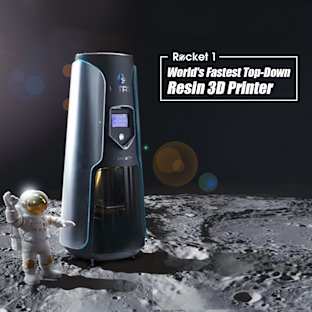The Indiegogo campaign has ended, and XC Tracer is now available at www.xctracer.com, shipping usually within 1-2 business days. There is also more information on the new website, including the newest firmware and instructions how to update the firmware.
XC Tracer is an advanced flight instrument for paragliders, using data from an 9-DOF IMU, from a pressure sensor and from a GPS to compute the real time climb rate and altitude, avoiding the undesired time lag that conventional variometers have due to data filtering.
Prototype of XC Tracer with 3D printed enclosure, same size as production version
The GPS provides also real time flight speed and direction. All the relevant information is then packed together in a custom NMEA like data string and sent over a Bluetooth Low Energy module to an iOS or Android tablet or phone. And of course the variometer indicates the climb / sink rate with beeping tones. It is very easy to fly in thermals with XC Tracer, since what you feel and what the variometer indicates do perfectly match.
There is a thread on Paraglidingforum about XC Tracer, including a first beta test review.
![]()
Test flight with XC Tracer prototype (white box) over the Swiss Alps
Additional to that the flight path is recorded on a micro SD card as a Google Earth KML file, or later on also an IGC file will be recorded instead of the KML file.
![]()
Google KML file, created with XC Tracer, 5Hz update rate
But it get's even better. XC Tracer is Arduino compatible, and once the campaign has been successfully funded then the code will be made open source. If you want to program a better data fusion algorithm, or if you want to log different data on the SD card, or if you have another idea than to use XC Tracer for flying, then just adapt the software according to your needs, upload the code to your XC Tracer and go ahead. And last but not least is XC Tracer Swiss Made!
![]()
Rendering of XC Tracer enclosure produced using injection moulding
XC Tracer in the production version will look as in the picture above, with the dimensions 57.5 x 57.5 x 19.25mm, and a weight of only 65g.
It is planned to make XC Tracer compatible with the following apps:
iOS
-
Flyskyhy (done!)
-
FreeFlight (initiated)
-
FreeFlightPro (initiated)
-
theVariometer
-
Thermgeek (done!)
-
SkyLogger (initiated)
-
SkyLoggerXXL (initiated)
-
Air Navigation Pro
- Chillout (done!)
Android
-
Gaggle
-
XCSoar (compatible using LXWP0 sentence)
-
PPGpS
-
G_Variometer
-
FlyMe (done!)
-
XCTrack
Windows
How it all began
As a paraglider pilot and designer since more than 25 years (right now working for Gin Gliders) I was always stunned that the principle how a hang glider variometer works has not changed since I learnt to fly paragliders. Variometers measure the rate of change of altitude by detecting the change in air pressure (static pressure) as altitude changes, and a filter “smoothes” the signal in order produce a usable beeping tone that indicates the climb and sink rate. But this filtering leads to an undesired time lag. While flying in thermals the variometer may still indicate a good climb rate, but in fact this may no longer be the case, it’s just because of the time lag that the variometer still beeps, indicating a false climb rate. You can feel this when flying, there is sometimes a discrepancy between what you feel and what the variometer indicates.
My idea was then to make just a variometer that also uses the vertical acceleration in order to calculate and indicate the vertical climb rate in real time, with no time lag. A first prototype device was flown in Winter 2014, in the video made below you can see how sensitive the variometer is.
First prototype of XC Tracer in January 2014
An attitude and heading reference system AHRS consist of microelectromechanical systems (MEMS) gyroscopes, accelerometers and magnetometers on all three axes. Using all the information from these sensors it is possible to calculate the orientation of the device in space, and therefore calculate the gravity compensated vertical acceleration. A Kalman filter then estimates the altitude and climb rate, using the vertical acceleration from the AHRS and the pressure from the pressure sensor.
That worked very well, the variometer had no time lag, but then when talking with friends they had the idea to integrate a GPS, then an SD card, then a BLE module for that the fligth information can be sent to a phone or a tablet...
This is how the idea of XC Tracer was born.
What has been done so far
The design of XC Traver went through many iterations. Below is a picture of an early, but already functional prototype.
![]()
Early prototype of XC Tracer
Many prototypes have been built and tested, and quite a few different PCB design iterations have been realized.
![]()
Some of the prototype PCB's used during development
The hardware and software are now ready for a serial production of XC Tracer. Below is the latest version of the hardware, based on an embedded
Teensy 3.1.
![]()
Last iteration of production PCB
Up to now the enclosured for the XC Tracer prototypes have been 3D printed, below are several examples of that.
![]()
3D printed enclosures, the blue version is identical in size to serial version
Next step, where your support is needed
The next step is now to prepare a series production of XC Tracer. The electronics will be Swiss Made and manufactured by
Hybrid SA,
certified according to ISO 9001. And the enclosure will be produced using injection moulding, and of course also be Swiss Made. But injection moulding is expensive, and it only makes sense to to that when enough customers want to have an XC Tracer. This is where your help will be needed. The funding campaign will help with 3 different tasks:
-
market study
-
prefinancing
-
presale
If the crowdfunding campaign is successful, that means if at least 100 customers or more make a pledge for one XC Tracer, then the production of these instruments in professional quality will start immediately. Once the first instruments are sent to customers the source code will be made public. Please help to make XC Tracer a success, and tell your friends about. If there are less then 100 XC Tracer presold on Indiegogo then nothing will happen, and your money will be sent back to your bank account.
Technical Specifications
-
57.5 x 57.5 x 19.25mm.
-
Weight is only 61g
- 14h battery autonomy
-
9-DOF IMU LSM9DSO
-
MS5637 Pressure Sensor
-
PA6H GPS with custom firmware, SBAS enabled at 5Hz
-
HM-11 BLE module, iOS and Android compatible
-
3 led for status indication
-
1200mAh LiPo battery with low discharge protection circuit
-
LiPo charger integrated
-
Arduino compatible, open source and hackable
-
ARM Cortex-M4 MK20DX256VLH7 Processor
-
Users can develop their own code
- Easy solution for non-programmers to update firmware over USB
- SanDisk Ultra microSDHC 8 GB
- Micro USB cable 1m
- Swiss Made
BLE data string specification:
$XCTRC,2015,1,5,16,34,33,36,46.947508,7.453117,540.32,12.35,270.4,2.78,,,,964.93,98*67
$XCTRC,year,month,day,hour,second,centisecond,latitude,longitude,altitude,speedoverground,course,climbrate,res,res,res,rawpressure,batteryindication*checksum
A second option is to use generic GPGGA and GPRMC NMEA sentences with 1Hz, and LXWP0 or LK8EX1 sentence with 10Hz.
Since XC Tracer is open source it will be easy to output other data, you can configure the data that will be sent over BLE according to your wishes.
What you will get
For one perk you will get a fully functional and Swiss Made XC Tracer with an enclosure made by injection moulding, a micro USB cable and a micro SD card with 8GB.
Plug your XC Tracer into an USB charger or an USB plug, charge until the green LED lights up, and then go fly with you new instrument. As soon as you take off the logging of a KML file will start, recording your position and altitude with a frequency of 5Hz. And of course data will be sent over BLE to your Android or iOS device for that you have all the flight information that you need. After landing simply switch off the device, the log file will be written to the SD card before the device will actually be switched off. Once at home take out the SD card and transfer the log file to a computer, and you will see the flight on Google Earth that you recorded.
Since XC Tracer is open source it will be easy to output other data, you can configure the data that will be sent over BLE according to your wishes.
Other ways to help
Please talk about this Indiegogo campaign and talk to your friends, make a post on Facebook, send your local paragliding club the link of the campaign. This may help to make this campaign a success.







































